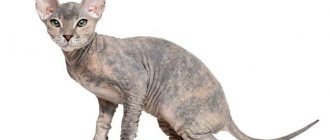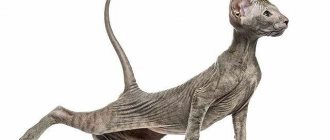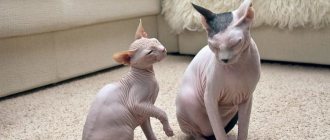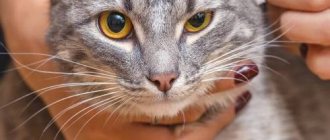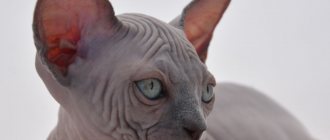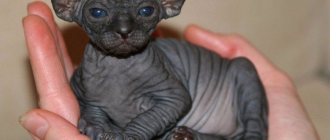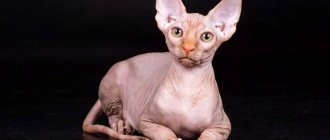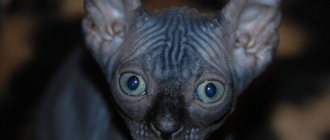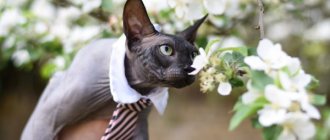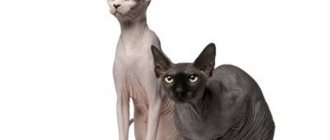The Sphynx is a hairless cat that evokes double feelings. Many are crazy about her unusual appearance, while others are repulsed by her alien features. In fact, a hairless cat (Sphynx cat) is a gentle, friendly and sociable creature. But before you decide to get such a kitten, you need to learn everything about sphinxes - what to feed, how to raise and properly care for them.
Sphynx cat: a brief history of the breed
Hairless cats are the result of a natural mutation. In ancient times they were popular and lived in the court of the Egyptian pharaohs. However, then their trace was lost. History is silent about what happened to those hairless representatives of the cat world.
According to some reports, until the 20s of the 20th century, there was a population of hairless cats in South America. These animals had an unusual appearance - a bald body, which was partially overgrown with hair only in the cold season, and large, expressive eyes of an amber hue. The South American breed of hairless cats has completely disappeared from the face of the earth, so its genetic characteristics cannot be studied.
In 1966, a hairless kitten appeared in one of the provinces of Ontario, Canada. The owner of a black and white short-haired cat discovered in her litter a baby completely different from the rest. He was bald and wrinkled, so his owner gave him the name Pruni, which means “prune.” When the hairless kitten grew up, the woman crossed him with his mother. It was not possible to achieve complete consolidation of the signs - hairless cats were found in only a few litters.
A few years later, 2 hairless cats were born in Minnesota, USA. Then active breeding work began. Hairless cats were crossed with representatives of other breeds. However, the best results were achieved when breeders used Devon Rex.
For a long time, felinologists did not recognize sphinxes because they feared that the mutation could provoke the development of serious diseases. Only in 1986 did TICA give the go-ahead for the participation of hairless cats in exhibitions and championships. Later this was done by the CCA and CFA organizations. The breed was called the “Canadian Sphynx”.
Sphynx cat: interesting facts
For those interested in Sphynxes, here are a few facts about these cute cats:
- They have an excellent appetite, as their body quickly gives off heat.
- Hairless cats come in different colors and even patterns on their bodies in the form of spots or stripes.
- Although the Sphynx seems too hot, its body temperature is almost the same as that of representatives of other breeds, only 0.5 degrees higher.
- A hairless cat can easily learn to open door handles and perform other manipulations.
- The Canadian Sphynx is not suitable for allergy sufferers.
Prices
Prices for hairless kittens are determined individually and depend on the pedigree and characteristics of a particular individual. Representatives of the Canadian, Don Sphynx and Peterbald breeds can cost from 10 to 50 thousand rubles. Ukrainian Levkoi are valued from 5 to 30 thousand rubles. The price range for Elves and Dwelfs is 35-120 thousand rubles. Bambino can be purchased for 25-80 thousand rubles. Kittens of the Cohona breed are extremely rare; there is no market price for these animals.
In any case, you should purchase cats only from nurseries, since breeding these pets at home is almost impossible. Adult cats become so attached to the owner that they may refuse to eat in the absence of the owner, so purchasing a pet of this breed should be taken with full responsibility.
Breed description, standards, appearance
The main feature of the sphinx is its naked, strong body, covered with folds, large ears like locators, and huge eyes. It is very pleasant to stroke such a cat - its skin resembles soft suede.
Sphynx cat - dimensions and weight
According to the official description, the Canadian Sphynx is a medium-sized cat with well-developed muscles. The average height at the withers is 30-35 cm. The weight of an adult Sphynx cat is 4-6 kg. Females are lighter and more graceful, their weight does not exceed 4.5 kg.
Anatomical characteristics
There are strict requirements for the appearance of sphinxes. According to the approved standard, cats should look like this:
- The head is medium-sized and has a wedge shape with smooth outlines.
- High cheekbones, strong chin.
- The frontal part of the Sphinx's head is flat, the muzzle is short.
- The ears are rounded at the ends and have a wide base. The outer edges extend slightly beyond the line of the head.
- The cat's whisker pads are convex, and the whiskers are either absent, curled or broken.
- Large oval eyes are located at a considerable distance from each other. The cat's gaze is a little slanted.
- The neck is quite strong, of medium length, smoothly turning into a wide, rounded chest.
- Muscular, strong body of medium length with a full belly.
- The length of the limbs is proportional to the body. The front legs are slightly shorter than the hind legs.
- Paws are oval with thick toes.
- The tail is long, thin, gradually tapering to the tip.
- Canadian Sphynxes have thick skin, which gathers into numerous folds on the head and neck.
Color and coat type
The colors of sphinxes are varied. They are determined by skin pigmentation and are:
- Plain. This group includes: black, white, blue, cream, lilac, red (red) and chocolate. Blue (gray) is a lightened version of the black color. If a Sphynx has pink skin, it means it is white.
- Two-color. They combine any color with white. The pigmented part of the skin should contrast against a light background. A mandatory requirement for a bicolor cat is that one ear must be colored.
- Color point. Kittens are born pink, but after some time they develop a dark mask on their nose, ears, paws and tail.
- Tortoiseshell. This color of the sphinx combines 3 colors - white, black, red. It occurs in females and males, but tortoiseshell cats cannot reproduce.
- Less common types of colors are van, tabby, harlequin, tonkin.
Although sphinxes appear to be completely naked, in reality they are not. Cats have fine hairs no more than 2 mm long on their bodies. Short and sparse hair is present on the outside of the ears, on the underbelly, between the toes and on the tail.
Possible breed defects
The disadvantage of the Sphynx breed is the presence of hair on those parts of the body where it should not be, as well as the length of the hairs is more than 2 mm. Other exterior defects:
- thin bones, graceful forms;
- underdeveloped muscles;
- straight profile;
- long and too narrow muzzle;
- small ears.
Attention! The body type of the Canadian Sphynx should not be similar to Devon Rex, Cornish Rex or Oriental cats.
Bambino
Bambino is difficult to confuse with other sphinxes - an adult animal weighs no more than 4–4.5 kilos.
External characteristics:
- hair on the body of most bambinos is completely absent, but some individuals have barely noticeable hair;
- a cat's eyes can be yellow or green;
- large ears are located vertically;
- The hind legs are longer than the front legs.
There is a woolen tassel at the tip of the tail, and the pet’s body is small and elongated.
Types of Sphynx cats
The Sphynx breed is represented by three species. In addition to the Canadian one, there is also the Don variety, which was bred in Rostov-on-Don, and the Peterbald - the creation of breeders from St. Petersburg.
The Canadian Sphynx is smaller than the Don Sphynx. The standard for this breed was approved in 1992. The Peterbald was obtained by crossing the Don variety with Oriental cats about 20 years ago.
Character and temperament of the Canadian Sphynx
Sphynx cats have high intelligence and a good-natured disposition. One of the main features of their character is their strong attachment to their owner. The pet follows him everywhere and willingly takes part in all activities. As soon as the opportunity presents itself, the cat will immediately sit next to you.
The Sphynx cat loves to climb on the shoulders or chest of the owner, closer to his face, rub against his owner's nose and purr softly. This is how they show complete trust. Sphynxes also love to talk.
A hairless cat cannot be left alone for a long time; it constantly needs communication and affection. Representatives of this breed become strongly attached to the members of the family in which they are raised. A long separation from the owner will be a real test for the Sphinx. Those who are forced to frequently go on business trips are not recommended to have such a cat.
Sphynxes are completely devoid of aggression, so you don’t have to be afraid to leave them alone with small children. A pet will never offend a child, even if he accidentally hurts him. Sphynxes get along well with other animals - small dogs, rabbits and cats of other breeds. Their hunting instinct is poorly developed, so they can be kept together with parrots, canaries or domestic rats.
Sphinxes feel comfortable even in a crowd of strangers if their owner is nearby. This character trait allows them to relax and show themselves in all their glory at the exhibition.
These are very smart cats. They easily remember commands, get accustomed to the tray and scratching post, and pick up the intonation of the owner. It may seem that the sphinx understands everything perfectly. You should not be rude when communicating with him, as he is extremely gentle and vulnerable. An offended cat will not take revenge, but someone who mistreats her may lose her trust forever.
How to choose the right kitten
When choosing a purebred kitten, there is no need to try to save money. It is better to buy a four-legged friend from a nursery with a good reputation. The breeder is responsible for each animal he sells, so he will not cheat. Kittens are sold with all documents - veterinary vaccination certificates, pedigree, passport.
Before buying a Sphynx, it is advisable to get to know his parents better, because later the baby will look like them. For those who do not intend to continue breeding hairless cats, a pet-class pet is suitable. This is a healthy cat that has minor conformation defects and therefore cannot participate in breeding work. Such sphinxes are cheaper and are bred solely for maintenance.
Kitten care
There are 3-5 kittens in a cat's litter. They are born blind. Babies' eyes open around the 3-4th day. In the first weeks after lambing, the mother takes care of the babies. She feeds, washes and warms the cubs with her body.
A month later, the sphinxes are given their first complementary foods. You can give low-fat cottage cheese or boiled lean chopped meat. Until the age of three months, cats are fed 6 times a day, then they are transferred to four meals a day. Adults eat in the morning and evening.
Small Sphynx cats require special care. It is important to keep your skin clean, as it quickly becomes oily. Once a week, the cat should be washed with warm water without soap, and wiped daily with wet wipes. The eyes and ears of naked cats are carefully cleaned with cotton pads soaked in a special product.
Vaccination
Sphynxes kept at home run the risk of becoming victims of viral and infectious diseases no less than their street counterparts. To protect cats of this breed from dangerous diseases, their care should include routine vaccination.
They are regularly vaccinated with a complex drug that stimulates the development of immunity to panleukopenia, calcivirosis and rhinotracheitis.
This is done for the first time when the kitten is 7-8 weeks old. After 4 weeks, the sphinx is revaccinated against the same diseases and against rabies. In the future, the cat is vaccinated annually, regardless of whether it is exclusively kept in an apartment or is on the street.
Important! Before vaccination, the animal must be subjected to antiparasitic treatment. Anthelmintic drugs are given to the cat 2 times with an interval of 10-14 days. The dose is calculated based on the pet's weight.
Sphynx cat - feeding
Hairless cats have faster metabolic processes than other breeds. They need more calories to maintain their body temperature.
Complete diet
When feeding dry formulas, preference is given to super-premium or holistic food from the following brands:
- Hills;
- Royal Canin;
- Acana;
- Pro Plan.
Some cat owners choose natural food for their pets. In this case, the Sphinx’s diet includes:
- lean meats - rabbit, veal, turkey, chicken;
- sea fish;
- cereals cooked in water without salt - buckwheat, rice, oatmeal;
- fermented milk products – low-fat cottage cheese, yogurt, sour cream;
- vegetables that have undergone heat treatment - carrots, broccoli, spinach;
- quail or chicken eggs (no more than 2 times a week).
Sphynx cats should not be fed processed foods, sausages, snacks, smoked meats, sweets, pork, bones and potatoes.
Sphynx cat - feeding frequency
Adult cats are fed 2 times a day - morning and evening. During the daytime, you can treat the sphinx with a small piece of treat. Small kittens should eat more often:
- from 1 to 3 months – 6 times a day;
- from 3 to 6 months – 4 times a day;
- from 6 to 9 months – 3 times.
Vitamins and minerals
There is no need to additionally introduce mineral and vitamin supplements into the Sphynx's diet if he eats high-quality industrial food.
Feeding is needed for cats that eat natural food. Complex preparations with vitamins must be given in courses 2 times a year. In order not to harm the health of the sphinx, you first need to show it to the veterinarian.
Diet
Animals that lack a layer of fur are forced to expend more energy to maintain a normal body temperature. For this reason, hairless cats should receive more high-calorie food. Basic recommendations for the correct selection of food:
- Avoid granules with high vitamin content. Such components are necessary for the beauty of the coat, but can cause harm to a bald cat.
- The diet should include a fairly large percentage of fat. Proteins with carbohydrates can remain at a basic level.
- When feeding natural products, you need to choose raw poultry and beef, boiled vegetables, meat, liver, and dairy products. The components can be crushed until smooth, added to soft foods, or given in their natural form, depending on the cat’s preferences.
Education and physical activity
When raising a Sphinx, you need to be persistent and patient. When training a cat, you should not yell at it or use force on it. It is better to use the incentive method. Every time your cat does what is expected of her, you should give her a treat.
Using this approach, the Sphinx can be taught:
- bring the ball on command;
- to open the door;
- and even flush the toilet.
Health and susceptibility to disease
The average lifespan of a Sphynx is 13-14 years. With good care, cats rarely get sick, but they still have a predisposition to certain diseases:
- Turning of the eyelids. This is a congenital pathology that surgery can correct.
- Vasculitis. An inflammatory process affecting the walls of blood vessels. The problem is manifested by the appearance of bluish or reddish dots on the skin.
- Kitten sleep syndrome. When homozygous sphinxes mate, non-viable kittens are born. Due to serious pathologies of internal organs, they die soon after birth.
- Acne. Acne in Sphynx cats occurs due to excess sebum production.
Color
There are various colors of hairless cats:
- plain (snow-white, charcoal, orange, bluish-gray, pink, purple, brownish);
- bicolor (gray-white, lilac-gray, brown-chocolate);
- with a pattern of various shades (tabby);
- tortoiseshell (black-red, cream-blue, cream-lilac);
- piebald (colored spots on a white background);
- colorpoint of various color combinations.
Silver colors of the Sphynx are not possible due to the lack of hair.
The variety of shades leads to the unique color of the skin of each individual. Having sunbathed a little under the sun's rays, the pet will look even more elegant, but such procedures should not be overused.
Sterilization and castration
If the Sphynx has defects that do not allow it to take part in future breeding, the cat must be castrated or sterilized. The procedure is carried out at the age of 7 to 12 months. Veterinarians do not recommend performing surgery too early, but it is advisable to do it before the moment when the cat wants to go for a walk.
Castration is performed under anesthesia, so it is absolutely painless. The operation lasts about 20 minutes. After its completion, the sphinx is taken home.
Sphynx cat: pros and cons
A hairless cat has many advantages, but there are also some disadvantages:
| pros | Minuses |
| Lack of fur | Need for careful care |
| Friendly disposition | Strong dependence on a person |
| High intelligence | Need for clothing (additional expenses) |
| Indiscriminate eating | High feed consumption |
| Good health | |
| A cat's ability to get along with other animals | |
| Underdeveloped hunting instinct | |
| Various color palette |
Owners of Sphynx cats speak of them with love and tenderness. They are often compared to dogs, because hairless pets follow their owner's heels and constantly climb into their arms.
A gentle and friendly creature with a non-standard appearance is ideal for both a lonely elderly person and families with small children.
Behavior
A common feature of representatives of hairless cats is an affectionate, flexible, friendly character. In this way, hairless cats are similar to dogs. They are affectionate and do not tolerate loneliness or change of environment well.
Some individuals can be trained, for example, they can bring light objects to their owner. They are distinguished by their intelligence, curiosity, and understanding of human speech.
They get along easily with small family members and pets. Many owners note that keeping such pets helps maintain a comfortable, relaxing atmosphere in the house.
